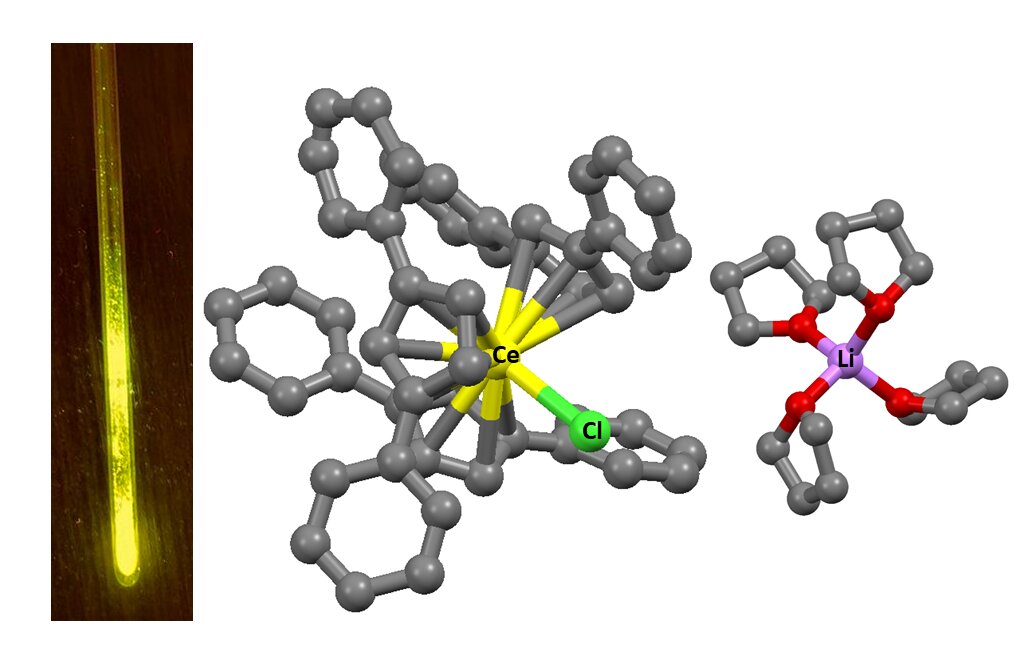Cerium Glows Yellow: Chemists Discover How to Control Luminescence of Rare Earth Elements
.jpg)
Researchers at HSE University and the Institute of Petrochemical Synthesis of the Russian Academy of Sciences have discovered a way to control both the colour and brightness of the glow emitted by rare earth elements. Their luminescence is generally predictable—for example, cerium typically emits light in the ultraviolet range. However, the scientists have demonstrated that this can be altered. They created a chemical environment in which a cerium ion began to emit a yellow glow. The findings could contribute to the development of new light sources, displays, and lasers. The study has been published in Optical Materials.
Rare earth elements are used in microelectronics, LEDs, and fluorescent materials because of their ability to emit light in precisely defined colours. This depends on how their electrons behave when absorbing and releasing energy.
When an atom absorbs energy—such as from light or an electric current—one of its electrons can be excited to a higher energy level. However, this excited state is unstable, and after a short time, the electron returns to its original level, releasing the excess energy as light. This process is known as luminescence.

In rare earth elements, the glow results from electron transitions between 4f orbitals—regions around the atomic nucleus where electrons can reside. Typically, the energy of these transitions is fixed, meaning the colour of the glow remains constant: cerium emits invisible ultraviolet light, while terbium emits green. The 4f orbitals are situated deep within the atom and interact minimally with the surrounding environment. In contrast, the 5d orbitals are sensitive to external influences but generally do not contribute to the luminescence of lanthanides due to their excessively high energy.
However, scientists from HSE University and the Institute of Petrochemical Synthesis of the Russian Academy of Sciences have demonstrated that the colour of the radiation can be altered by adjusting the chemical environment of the metals. They synthesised cerium, praseodymium, and terbium complexes using organic ligands—molecules that surround metal ions. These ligands shape the geometry of the complex and influence its properties. In all cases, three cyclopentadienyl anions were symmetrically arranged around the metal. These anions consist of regular pentagons of carbon atoms, to which large organic fragments are attached, providing the required structure for the complex. This environment generates a specific electrostatic field around the ion, which alters the energy of the 5d orbitals and, consequently, affects the luminescence spectrum.

Daniil Bardonov
'Previously, a change in the colour of the glow had been observed, but the underlying mechanism was not understood. Now, in collaboration with our physicist colleagues, we have been able to understand the mechanism behind this effect. We deliberately designed compounds with an electronic structure that is atypical for lanthanides. Rather than focusing on a single example, we synthesised a series of compounds from cerium to terbium to observe how their properties change and to identify common patterns,' comments Daniil Bardonov, a master's student at the HSE Faculty of Chemistry.
In conventional compounds, cerium emits ultraviolet light with wavelengths between 300 and 400 nanometres. In the new complexes, its emission shifted to the red range, reaching up to 655 nanometres. This indicates that the energy gap between the 4f and 5d levels has decreased. A similar rearrangement of electronic levels was observed in the other lanthanides studied, also resulting in changes to their luminescence.

Dmitrii Roitershtein
'To understand how this process works, it’s important to first grasp the mechanism of energy transfer. Typically, a ligand molecule absorbs ultraviolet light, enters an excited state, and then transfers this energy to the metal atom, causing it to emit light,' explains Dmitrii Roitershtein, Academic Supervisor of the Chemistry of Molecular Systems and Materials Programme and co-author of the paper. 'However, in the new compounds, the process occurred differently: energy was transferred not directly to the 4f electrons, but via an intermediate 5d state.'
The researchers believe that being able to predict the luminescence spectrum will make it possible to design materials with desired properties more efficiently by eliminating the need for time-consuming trial and error. This could facilitate the creation of new and advanced light sources.
'We were able to demonstrate exactly how the environment of an atom influences its electronic transitions and lanthanide luminescence,' says Fyodor Chernenkiy, bachelor's student at the HSE Faculty of Chemistry. 'We can now intentionally select the structure of compounds to control luminescence and produce materials with specific optical properties.'
See also:
Immune System Error: How Antibodies in Multiple Sclerosis Mistake Their Targets
Researchers at HSE University and the Institute of Bioorganic Chemistry of the Russian Academy of Sciences (IBCh RAS) have studied how the immune system functions in multiple sclerosis (MS), a disease in which the body's own antibodies attack its nerve fibres. By comparing blood samples from MS patients and healthy individuals, scientists have discovered that the immune system in MS patients can mistake viral proteins for those of nerve cells. Several key proteins have also been identified that could serve as new biomarkers for the disease and aid in its diagnosis. The study has been published in Frontiers in Immunology. The research was conducted with support from the Russian Science Foundation.
Scientists Develop Effective Microlasers as Small as a Speck of Dust
Researchers at HSE University–St Petersburg have discovered a way to create effective microlasers with diameters as small as 5 to 8 micrometres. They operate at room temperature, require no cooling, and can be integrated into microchips. The scientists relied on the whispering gallery effect to trap light and used buffer layers to reduce energy leakage and stress. This approach holds promise for integrating lasers into microchips, sensors, and quantum technologies. The study has been published in Technical Physics Letters.
HSE Scientists Test New Method to Investigate Mechanisms of New Word Acquisition
Researchers at the HSE Centre for Language and Brain were among the first to use transcranial alternating current stimulation to investigate whether it can influence the acquisition of new words. Although the authors of the experiment have not yet found a link between brain stimulation and word acquisition, they believe that adjusting the stimulation parameters may yield different results in the future. The study has been published in Language, Cognition and Neuroscience.
Twenty vs Ten: HSE Researcher Examines Origins of Numeral System in Lezgic Languages
It is commonly believed that the Lezgic languages spoken in Dagestan and Azerbaijan originally used a vigesimal numeral system, with the decimal system emerging later. However, a recent analysis of numerals in various dialects, conducted by linguist Maksim Melenchenko from HSE University, suggests that the opposite may be true: the decimal system was used originally, with the vigesimal system developing later. The study has been published in Folia Linguistica.
Scientists Rank Russian Regions by Climate Risk Levels
Researchers from HSE University and the Russian Academy of Sciences have assessed the levels of climate risks across Russian regions. Using five key climate risks—heatwaves, water stress, wildfires, extreme precipitation, and permafrost degradation—the scientists ranked the country’s regions according to their need for adaptation to climate change. Krasnoyarsk Krai, Irkutsk Region, and Sverdlovsk Region rank among the highest for four of the five climate risks considered. The study has been published in Science of the Total Environment.
HSE Researchers Teach Neural Network to Distinguish Origins from Genetically Similar Populations
Researchers from the AI and Digital Science Institute, HSE Faculty of Computer Science, have proposed a new approach based on advanced machine learning techniques to determine a person’s genetic origin with high accuracy. This method uses graph neural networks, which make it possible to distinguish even very closely related populations.
HSE Economists Reveal the Secret to Strong Families
Researchers from the HSE Faculty of Economic Sciences have examined the key factors behind lasting marriages. The findings show that having children is the primary factor contributing to marital stability, while for couples without children, a greater income gap between spouses is associated with a stronger union. This is the conclusion reported in Applied Econometrics.
Fifteen Minutes on Foot: How Post-Soviet Cities Manage Access to Essential Services
Researchers from HSE University and the Institute of Geography of the Russian Academy of Sciences analysed three major Russian cities to assess their alignment with the '15-minute city' concept—an urban design that ensures residents can easily access essential services and facilities within walking distance. Naberezhnye Chelny, where most residents live in Soviet-era microdistricts, demonstrated the highest levels of accessibility. In Krasnodar, fewer than half of residents can easily reach essential facilities on foot, and in Saratov, just over a third can. The article has been published in Regional Research of Russia.
HSE Researchers Find Counter-Strike Skins Outperform Bitcoin and Gold as Alternative Investments
Virtual knives, custom-painted machine guns, and gloves are common collectible items in videogames. A new study by scientists from HSE University suggests that digital skins from the popular video game Counter-Strike: Global Offensive (CS:GO) rank among the most profitable types of alternative investments, with average annual returns exceeding 40%. The study has been published in the Social Science Research Network (SSRN), a free-access online repository.
HSE Neurolinguists Reveal What Makes Apps Effective for Aphasia Rehabilitation
Scientists at the HSE Centre for Language and Brain have identified key factors that increase the effectiveness of mobile and computer-based applications for aphasia rehabilitation. These key factors include automated feedback, a variety of tasks within the application, extended treatment duration, and ongoing interaction between the user and the clinician. The article has been published in NeuroRehabilitation.


